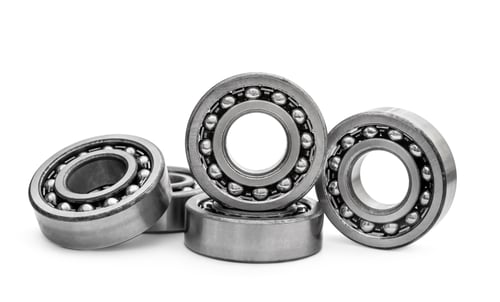What is a bearing vibration monitoring sensor?
WHAT IS A BEARING VIBRATION SENSOR AND HOW DOES IT WORK?
A bearing vibration sensor is a specialized device that detects and measures vibration levels in rotating equipment, such as motors, pumps and fans. It enables early fault detection, helping to prevent equipment failures and unexpected downtime. The sensors works by utilizing accelerometers to measure the vibration generated by rotating components, including bearings.
- The accelerometer within the sensor converts mechanical vibrations into electrical signals
- Electrical signals are analyzed to determine the severity, frequency, and characteristics of the vibrations
- Advanced algorithms and signal processing techniques are applied to interpret the vibration data and identify potential defects or abnormalities in the bearings

BENEFITS OF USING A BEARING VIBRATION SENSOR
- Early Fault Detection: The bearing vibration sensor provides real-time monitoring, enabling the detection of emerging faults at their initial stages. This allows for timely maintenance interventions to prevent catastrophic failures and costly downtime.
- Increased Equipment Reliability: By continuously monitoring the vibrations, the sensor helps to ensure the reliable operation of rotating equipment. It aids in identifying issues such as misalignment, imbalance, bearing wear, and lubrication problems, allowing for timely corrective actions.
- Cost Savings: Proactive maintenance based on the insights from the bearing vibration sensor minimizes the need for reactive repairs, reducing overall maintenance costs and optimizing the utilization of resources.
- Enhanced Safety: By detecting potential faults early on, the sensor contributes to a safer working environment, mitigating the risk of accidents or equipment damage caused by unexpected failures.
DIFFERENT TYPES OF BEARING VIBRATION SENSORS
- Portable Handheld Sensor: These sensors are convenient for spot-checking or performing periodic inspections on equipment. They are lightweight, easy to use, and ideal for troubleshooting purposes.
- Online Continuous Monitoring: These sensors are permanently installed on the equipment and provide real-time monitoring of vibration levels. They offer continuous insights into the health of the bearings, enabling proactive maintenance planning.
- Wireless Sensor Nodes: Utilizing wireless technology, these sensor nodes provide flexibility in sensor placement and allow for remote monitoring or equipment. They are particularly useful for applications where wired connections are impractical or cost-prohibitive.
INSTALLING A BEARING VIBRATION SENSOR PROPERLY
- Proper Sensor Placement: The correct placement of the sensor on the equipment is crucial for accurate measurements. Consult the manufacturer's guidelines and consider factors such as proximity to the bearings, mounting surface and orientation.
- Secure Mounting: Ensure that the sensor is securely mounted to minimize any potential movement or interference that may affect the accuracy of the vibration measurements.
- Sensor Calibration: Follow the manufacturer's instructions to calibrate the sensor, ensuring precise and reliable measurements.
FINDING THE RIGHT MODEL FOR YOUR NEEDS
- Consider Equipment Specifications: Evaluate the specific requirements of your equipment, such as operating conditions, size, and type of bearings, to determine the appropriate sensor model that can effectively monitor vibrations.
- Consult with Experts: Seek guidance from industry experts or sensor manufacturers to identify the most suitable sensor for your application. They can provide insights based on their experience and knowledge of different equipment types and industries.
TAKING CARE OF YOUR BEARING VIBRATION SENSOR TO ENSURE LONG-TERM PERFORMANCE
- Regular Inspection and Maintenance: Periodically inspect the sensor for any signs of damage or wear. Follow the manufacturer guidelines for maintenance, including cleaning, recalibration, and battery replacement if applicable.
- Environmental Considerations: Protect the sensors from extreme temperatures, moisture, and excessive vibration that could affect its performance. Ensure that the sensor is installed in a suitable enclosure or housing if needed.
- Training and Expertise: Provide adequate training to personnel responsible for operating and maintaining the sensor. Familiarize them with best practices, troubleshooting techniques, and interpretation of vibration data to make informed maintenance decisions.
- Data Analysis and Reporting: Implement a robust data analysis system to effectively interpret and analyze the vibration data collected by the sensor. Utilize advanced analytics tools and software to identify trends, anomalies, and potential faults. Generate comprehensive reports that highlight equipment health, vibration levels, and recommended actions for maintenance personnel.
WHY CONDITION MONITORING?
Unplanned downtime poses a significant challenge for manufacturers, resulting in annual losses around $20 billion. Reactive maintenance practices contribute to 70% of industrial injuries. Equipment uptime directly impacts plant productivity and output, making unplanned shutdowns due to poorly maintained equipment extremely costly.
Condition monitoring is a proactive maintenance strategy that continuously monitors equipment and systems, enabling early fault detection and timely maintenance actions. By implementing condition monitoring, manufacturers can prevent unplanned downtime, maximize equipment uptime, and save substantial amounts of money. Additionally, it enhances workplace safety by reducing the likelihood of injuries associated with reactive maintenance.
FAQ
Vibration monitoring in bearings is crucial for early fault detection and preventive maintenance. It allows for identification of abnormal vibration patterns, which can indicate underlying issues such as misalignment, imbalance, bearing wear, or lubrication problems. By monitoring vibrations, potential problems can be addressed proactively, preventing costly breakdowns and optimizing equipment performance.
A vibration monitoring system continuously monitors the vibrations of rotating equipment, such as bearings, and analyzes the data to detect anomalies. It utilizes sensors to measure vibration levels, collects data, and applies advanced algorithms for analysis. By tracking vibrations over time, the system can identify deviations from normal behavior, enabling timely maintenance interventions and preventing equipment failures.
Without a condition monitoring system, bearing vibration can be checked manually using portable vibration measurement tools, such as handheld vibration meters. These devices are placed near the bearing, and the measured vibrations are compared to established vibration guidelines. However, manual checks are often limited in frequency and may not capture subtle changes over time.
With a condition monitoring system, such as GraceSense's Vibration and Temperature Nodes, continuous monitoring is achieved. Sensors are installed on the bearings, and the system collects and analyzes vibration data in real-time. This provides a more comprehensive and accurate assessment of bearing health, enabling early fault detection and proactive maintenance actions.
GraceSense Predictive Maintenance System
Condition Monitoring Solution
